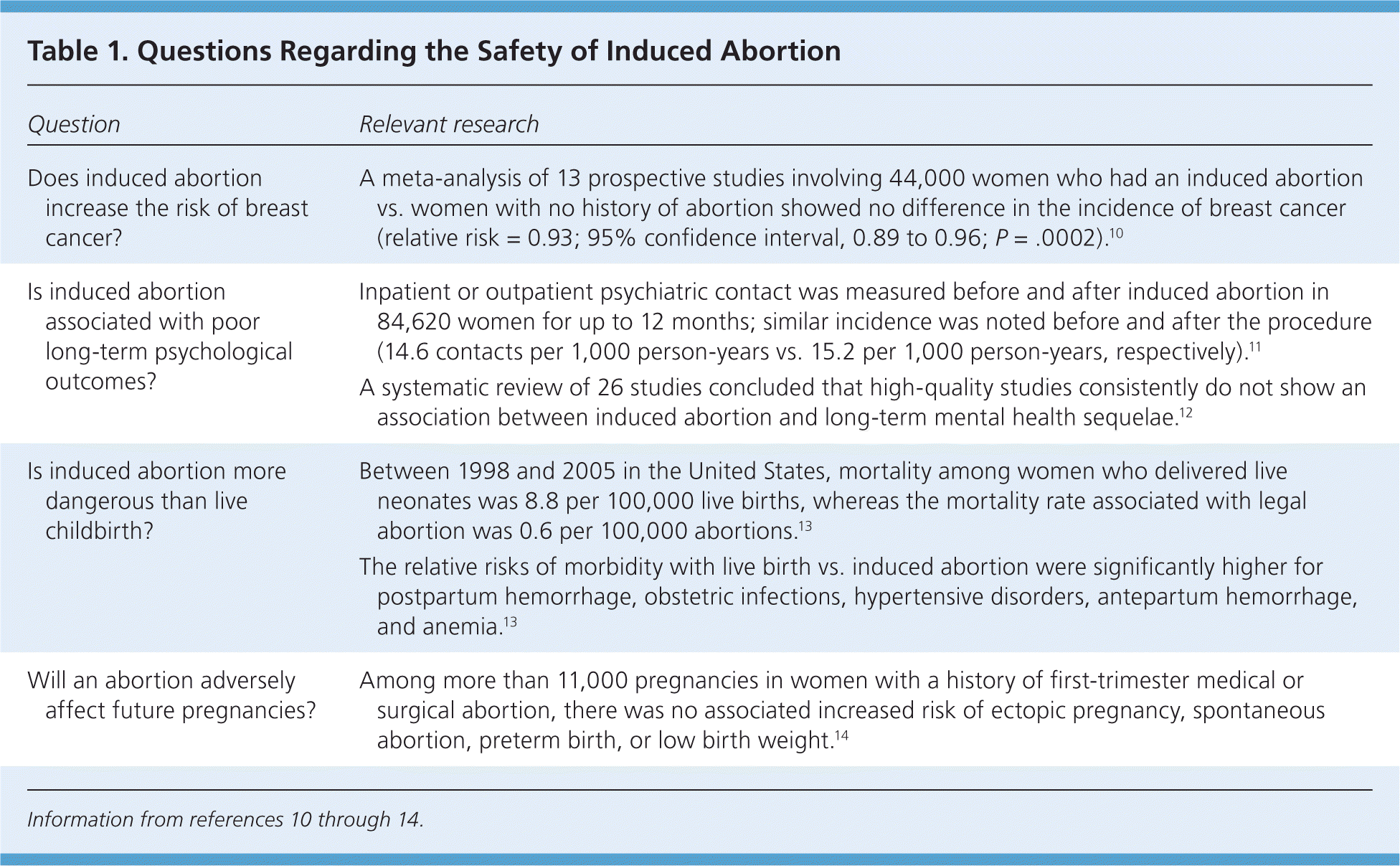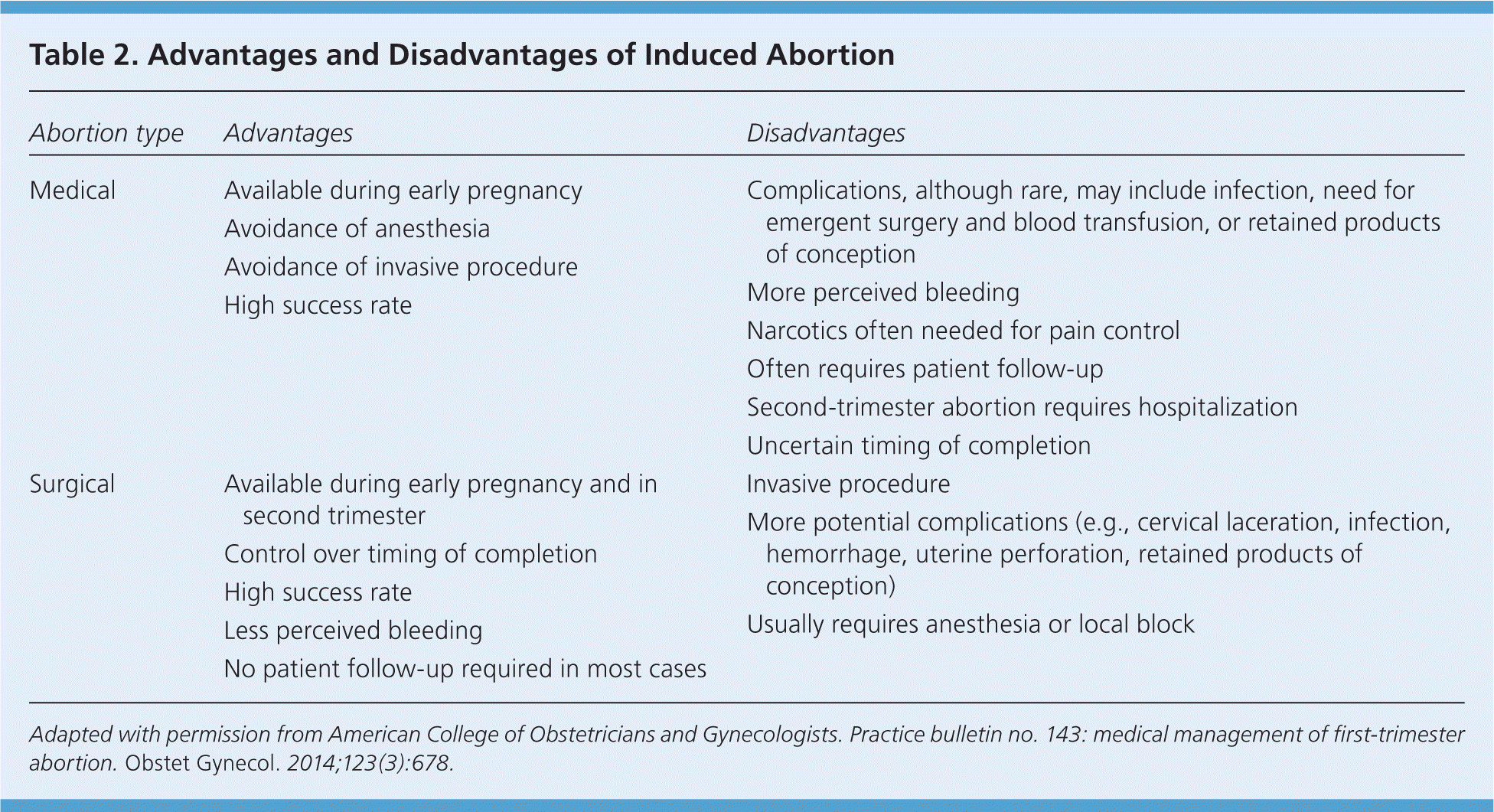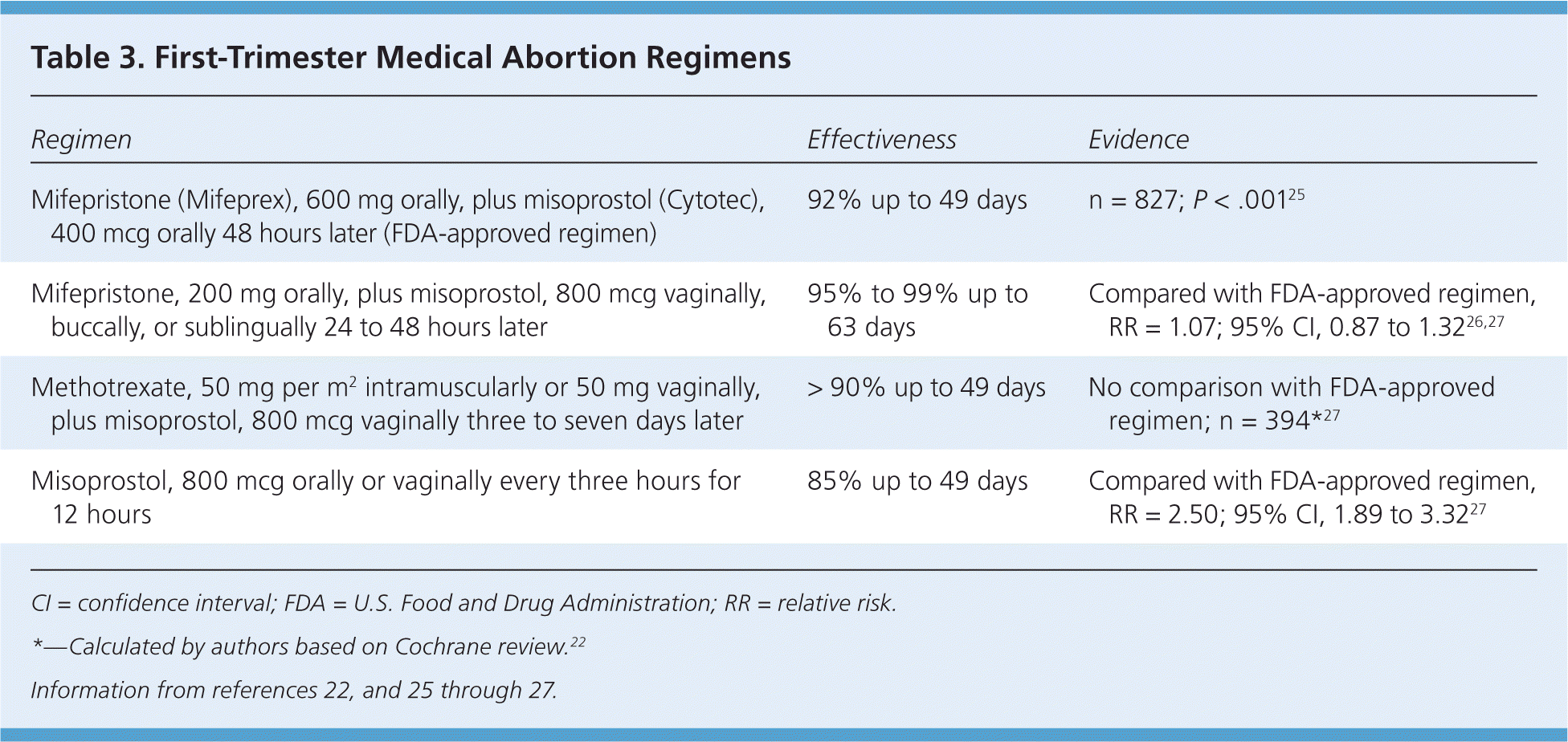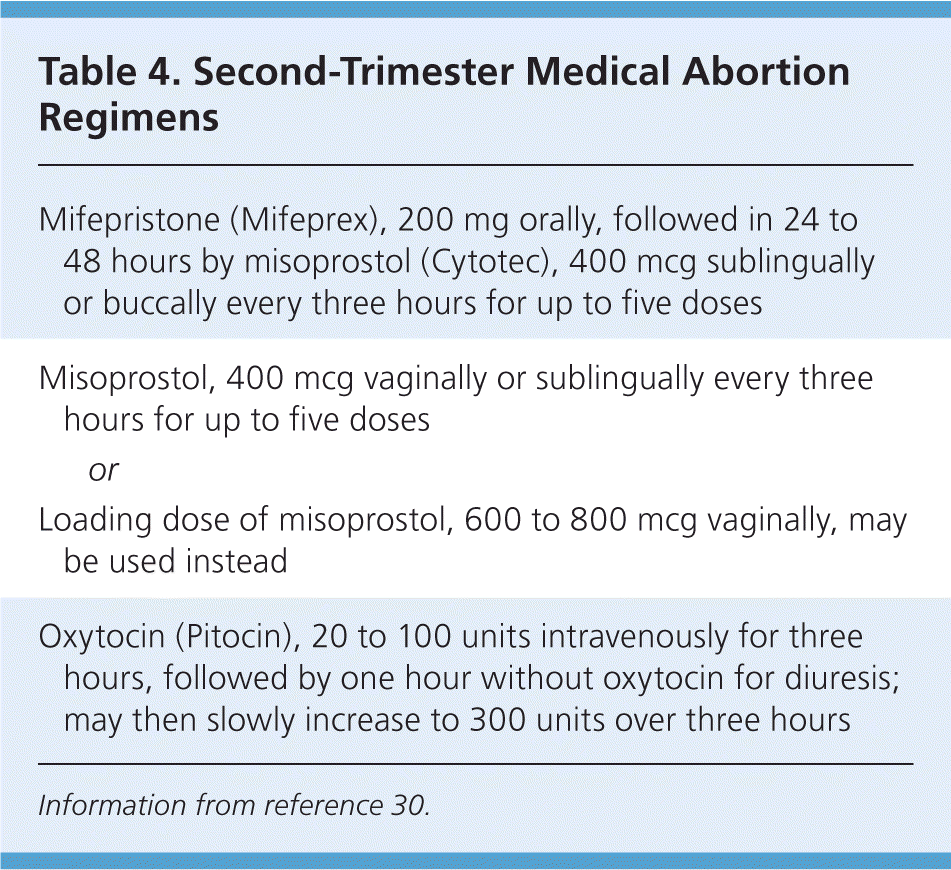
A more recent article on options for unintended pregnancies is available.
Am Fam Physician. 2015;91(8):544-549
Related Curbside Consultation: Counseling Patients with Unintended Pregnancy.
Patient information: See related handout on unintended pregnancy, written by the authors of this article.
Author disclosure: No relevant financial affiliations.
Unintended pregnancy refers to unwanted, unplanned, or mistimed pregnancies. One-half of all pregnancies in the United States are unintended, and family physicians are often asked to provide counseling, support, and resources for women with unintended pregnancies. Options include carrying the infant to term and raising the child, carrying the infant to term and choosing adoption, or having an induced abortion. Family physicians should be equipped to direct women who choose to raise the infant to appropriate care and resources. Most U.S. women do not choose adoption, but there are multiple resources for women interested in this option. Physicians should not broker adoptions, match potential parents with mothers, or adopt children of their own patients. Induced abortion is performed in the first or second trimester of pregnancy. Medical management is comparable with surgical management, and both methods are safe and effective. Combination regimens with mifepristone and misoprostol are the most effective medical methods. Dilation and curettage and vacuum aspiration are the most common surgical methods.
Unwanted, unplanned, or mistimed pregnancies are considered unintended. According to the 2006–2008 National Survey of Family Growth, approximately one-half of all pregnancies in the United States are unintended, with 29% mistimed and 19% unwanted; 43% of these pregnancies end in abortion.1 Each year, unintended pregnancies are associated with more than $11 billion in health care spending.1 Unintended pregnancies can be stressful, and family physicians can help by providing unbiased medical information and options to women and their families.
| Clinical recommendation | Evidence rating | References |
|---|---|---|
| Physicians should provide unbiased, medically accurate information regarding options for women with unintended pregnancy. | C | 9, 15, 16 |
| Physicians should not broker adoption, match prospective parents with pregnant women, or adopt children from their patients. | C | 21 |
| Medical and surgical abortions are comparably safe and effective. | A | 10–14, 22–28, 30, 31 |
| For first-trimester medical abortion, 200 mg of oral mifepristone (Mifeprex) plus 800 mcg of misoprostol (Cytotec) given vaginally, buccally, or sublingually is superior to 600 mg of oral mifepristone plus 400 mcg of oral misoprostol. | A | 27 |
| Combination regimens are superior to single agents for medical abortions. | A | 23, 25–27 |
Risk Factors
Understanding risk factors for unintended pregnancy can assist family physicians during contraceptive and preconception counseling. In a survey of more than 1,300 women in 13 family planning clinics, risk factors for unprotected intercourse included difficulty obtaining contraceptives, less than a college education, age 20 to 24 years, and black race.2 Additionally, in observational data obtained from nearly 1,500 females 14 to 40 years of age, women with unintended pregnancy had less social support (mean number of friends = 2.5 vs. 3.0; P = .005), more depressive symptoms (67% vs. 49%; P < .05), and a higher level of perceived current stress (6.9 vs. 5.6 on a 10-item scale; P < .001) compared with women with intended pregnancy.3 Childhood sexual assault and current depressive symptoms were also positively associated with reports of sadness and the desire to abort. Women with a history of intimate partner violence have increased odds of unintended pregnancy (odds ratio [OR] = 1.69; 95% confidence interval [CI], 1.53 to 1.86) and abortion (OR = 2.68; 95% CI, 2.34 to 3.06).4 Factors associated with unintended pregnancy include obtaining less than the recommended amount of preconception folic acid (OR = 2.39; 95% CI, 1.7 to 3.2), prenatal tobacco use (OR = 2.03; 95% CI, 1.5 to 2.9), postnatal tobacco use (OR = 1.86; 95% CI, 1.35 to 2.55), postpartum depression (OR = 1.98; 95% CI, 1.48 to 2.64), and being less likely to initiate first-trimester prenatal care (OR = 0.34; 95% CI, 0.3 to 0.5).5
Initial Evaluation
Pregnancy is often suspected based on results from a home pregnancy test, and is confirmed in a clinic with a urine or blood test. An accurate estimated gestational age should be calculated. For women with a certain last menstrual period (LMP), this can be done using Naegele's rule (LMP + 7 days + 9 months),6 a paper wheel, or an electronic app. In a recent study, only 35% of paper wheels were accurate, whereas 100% of electronic apps calculated the correct date.7 Alternatively, ultrasonography can be used to calculate or confirm the estimated gestational age. First-trimester ultrasonography using crown-rump measurement is the most accurate means for ultrasound dating of pregnancy.8
Options for Unintended Pregnancy
There are three options for any pregnancy: carrying the fetus to delivery and raising the child, carrying the fetus to delivery and choosing adoption, or having an induced abortion. The physician's role is to help patients make an informed decision and guide them to available resources, particularly when patients choose adoption or abortion. Physicians should approach the discussion in a nonjudgmental way and respect the decision and rights of the patient. They should avoid coercion in any form, and they must present impartial and medically accurate characterizations of reproductive options.9 Questions regarding the safety of induced abortion are common (Table 1).10–14 Access to follow-up care is essential, and patients should realize they can change their mind during the pregnancy.15

| Question | Relevant research |
|---|---|
| Does induced abortion increase the risk of breast cancer? | A meta-analysis of 13 prospective studies involving 44,000 women who had an induced abortion vs. women with no history of abortion showed no difference in the incidence of breast cancer (relative risk = 0.93; 95% confidence interval, 0.89 to 0.96; P = .0002).10 |
| Is induced abortion associated with poor long-term psychological outcomes? | Inpatient or outpatient psychiatric contact was measured before and after induced abortion in 84,620 women for up to 12 months; similar incidence was noted before and after the procedure (14.6 contacts per 1,000 person-years vs. 15.2 per 1,000 person-years, respectively).11 |
| A systematic review of 26 studies concluded that high-quality studies consistently do not show an association between induced abortion and long-term mental health sequelae.12 | |
| Is induced abortion more dangerous than live childbirth? | Between 1998 and 2005 in the United States, mortality among women who delivered live neonates was 8.8 per 100,000 live births, whereas the mortality rate associated with legal abortion was 0.6 per 100,000 abortions.13 |
| The relative risks of morbidity with live birth vs. induced abortion were significantly higher for postpartum hemorrhage, obstetric infections, hypertensive disorders, antepartum hemorrhage, and anemia.13 | |
| Will an abortion adversely affect future pregnancies? | Among more than 11,000 pregnancies in women with a history of first-trimester medical or surgical abortion, there was no associated increased risk of ectopic pregnancy, spontaneous abortion, preterm birth, or low birth weight.14 |
CONSCIENTIOUS REFUSAL
When caring for women with unintended pregnancy, physicians may exercise conscientious refusal if they are morally opposed to a patient's decision. In a policy letter on reproductive decisions, the American Academy of Family Physicians (AAFP) states that a physician should not be compelled to perform any act that violates his or her good judgment or personally held moral principles, and may withdraw from the case as long as withdrawal is consistent with good medical practice.16 However, the AAFP also states that a woman who is considering an elective abortion should be adequately informed about the potential health risks of abortion and continued pregnancy. The physician should provide her with information about (1) financial and other assistance available to both her and the child; (2) the availability of licensed or regulated adoption agencies if she chooses not to keep the child; and (3) the availability of safe, legal abortion services if she chooses not to continue the pregnancy; or the physician should identify resources where such information can be obtained.16 In addition, the American College of Obstetricians and Gynecologists recommends that physicians who are not willing to provide specific reproductive services should have referral processes in place to provide for transfer of care in a timely manner. Physicians should give advance notice of their personal moral commitments and should not advocate or argue their position to patients.9
RAISING THE INFANT
Family physicians can have an important role in assisting women who decide to continue the pregnancy and raise the infant. A physician's role may be not only to provide prenatal care, but also to direct the patient to resources that may help her and her family with the pregnancy and the subsequent care of the infant. Physicians can familiarize themselves with local public health agencies to help with medical, financial, and social or spiritual resources. Because of some patients' socioeconomic limitations, coordination of transportation and care may be necessary.
ADOPTION
According to data from the National Survey of Family Growth, voluntary placement of children for adoption is relatively rare in the United States. Data from their 1995 survey show that less than 1% of children born to never-married women were placed for adoption.17 The percentage for white women is higher than for black women (1.7% vs. near 0%, respectively). Extrapolation of these percentages to the 1.4 million births to unmarried women in 2003 would mean that fewer than 14,000 children were placed for adoption.17
Most adoption research has focused on unmarried teenagers. Post-birth surveys show that women with higher education levels and high career or educational aspirations are more likely to choose adoption.18 Women who had positive personal experiences with adoption are more willing to place their child with adoptive parents.18,19 Pregnant teenagers whose boyfriends or mothers wanted them to choose adoption were much more likely to do so. In addition, women who expected little assistance with child care from their mothers were more likely to choose adoption.20
Adoption occurs through licensed private or state-run adoption agencies or through informal transfer of care that may not include formal relinquishment of all parental rights and responsibilities. In the past, most adoptions were closed, meaning the birth mother did not maintain contact with the child or adoptive parents. Most adoptions now have some level of openness, allowing the birth mother to maintain a prearranged amount of contact with the child or adoptive parents. Adoption laws vary by state and can be complex. The U.S. Department of Health and Human Services offers comprehensive information for expectant parents who are considering adoption, including information on adoption laws by state, on the Child Welfare Information Gateway (https://www.childwelfare.gov/topics/adoption/).
Although adoption is not technically a medical matter, physicians may be asked to provide information, advice, or prenatal care. Several principles can assist family physicians in these cases. Assisting the patient in decision making and with coordination of care may require referrals to other professionals, such as social workers. Because of the potential for undue influence, physicians should not act as brokers for adoption, match prospective parents with mothers, or attempt to adopt the child of a patient they care for medically.21 Hospital policies regarding adoption should be reviewed before labor begins. The primary responsibility of the physician is to the patient, not the adoptive parents. Previously, adopted infants were removed immediately after delivery. Women can now decide whether to hold the infant, breastfeed, or even care for the infant until discharge from the hospital.21
INDUCED ABORTION
Induced abortion is performed in the first or second trimester of pregnancy and involves either medical or surgical methods.22 The first trimester is defined as up to 12 completed weeks of gestation, and the second trimester is defined as 13 to 26 weeks of gestation. The advantages and disadvantages of medical vs. surgical abortion are listed in Table 2.23 Abortion laws, including how late in pregnancy an abortion can be performed, vary by state. A summary of these laws can be found at the Guttmacher Institute website (http://www.guttmacher.org/statecenter/spibs/spib_OAL.pdf).24

| Abortion type | Advantages | Disadvantages |
|---|---|---|
|
|
|
|
|
|
Most medically induced abortions occur in the first trimester, are uncomplicated, and can be managed by family physicians. First-trimester medical abortion generally involves the use of mifepristone (Mifeprex), a derivative of norethindrone that acts as a progesterone receptor antagonist, followed by misoprostol (Cytotec) up to 72 hours later. The regimen approved by the U.S. Food and Drug Administration (FDA) includes 600 mg of oral mifepristone, followed by 400 mcg of oral misoprostol. This regimen is 92% effective up to 49 days' gestation.25 Complete abortion rates are higher with earlier gestations. Non–FDA-approved combinations that include 200 mg of oral mifepristone followed by 800 mcg of misoprostol given vaginally, buccally, or sublingually up to 72 hours later have an overall success rate of 95% to 99% up to 63 days' gestation.26,27 Although the FDA-approved regimen and non–FDA-approved regimens have similar effectiveness (relative risk = 1.07; 95% CI, 0.87 to 1.32), the non–FDA-approved regimens are considered superior because of their reduced rate of adverse effects and lower cost.23 Other less commonly used—and less effective—medical abortion regimens include misoprostol only and methotrexate followed by misoprostol27 (Table 322,25–27). Infection after medical abortion is rare, and there is no strong evidence to support the universal use of prophylactic antibiotics. The mother's Rh status should be determined, and Rho(D) immune globulin (RhoGam) should be administered, if indicated.23

| Regimen | Effectiveness | Evidence |
|---|---|---|
| Mifepristone (Mifeprex), 600 mg orally, plus misoprostol (Cytotec), 400 mcg orally 48 hours later (FDA-approved regimen) | 92% up to 49 days | n = 827; P < .00125 |
| Mifepristone, 200 mg orally, plus misoprostol, 800 mcg vaginally, buccally, or sublingually 24 to 48 hours later | 95% to 99% up to 63 days | Compared with FDA-approved regimen, RR = 1.07; 95% CI, 0.87 to 1.3226,27 |
| Methotrexate, 50 mg per m2 intramuscularly or 50 mg vaginally, plus misoprostol, 800 mcg vaginally three to seven days later | > 90% up to 49 days | No comparison with FDA-approved regimen; n = 394*27 |
| Misoprostol, 800 mcg orally or vaginally every three hours for 12 hours | 85% up to 49 days | Compared with FDA-approved regimen, RR = 2.50; 95% CI, 1.89 to 3.3227 |
Vacuum aspiration and dilation and curettage are the most commonly used surgical methods for first-trimester pregnancy termination in the United States.28 They are equally effective and have similar complication rates. Perioperative antibiotics prevent upper genital tract infections after surgical abortion.29 Dilation of the cervix using osmotic dilators, prostaglandins, or mechanical methods is usually necessary before performing the aspiration or curettage component of the procedure. Vacuum aspiration is performed with a manual vacuum device or an electric vacuum aspirator.28
Medically induced abortion may be preferred in the second trimester if the woman wishes to avoid a surgical procedure and prefers to have an intact fetus. Multiple regimens exist (Table 4).30 Patients are usually admitted to the hospital because the duration of the abortion is variable and may result in more blood loss.30

| Mifepristone (Mifeprex), 200 mg orally, followed in 24 to 48 hours by misoprostol (Cytotec), 400 mcg sublingually or buccally every three hours for up to five doses | |
| Misoprostol, 400 mcg vaginally or sublingually every three hours for up to five doses | |
| or | |
| Loading dose of misoprostol, 600 to 800 mcg vaginally, may be used instead | |
| Oxytocin (Pitocin), 20 to 100 units intravenously for three hours, followed by one hour without oxytocin for diuresis; may then slowly increase to 300 units over three hours |
Second-trimester surgical abortion involves the dilation and evacuation technique. Bilateral fetal upper and lower extremities, spine, and cranium must be accounted for after both medical and surgical abortion.31
Abdominal surgery such as hysterectomy or hysterotomy is rarely required for second-trimester abortion and is performed only if dilation and evacuation or medical abortion has failed or is contraindicated.31
Counseling Patients with Unintended Pregnancy
Women with unintended pregnancy may seek counseling from their family physician. Depending on the circumstances, this can be challenging. To assist our readers, this issue of American Family Physician also contains a Curbside Consultation feature to offer more guidance on counseling techniques.
Data Sources: A PubMed search was completed in Clinical Queries using the key terms abortion and induced. The search included meta-analyses, randomized controlled trials, clinical trials, and reviews. PubMed searches were completed using the terms abortion, induced abortion, and adoption. Essential Evidence Plus, the National Guideline Clearinghouse, the Cochrane Database of Systematic Reviews, and bibliographies were also searched. Search dates: September 25, 2014, and January 30, 2015.
The views expressed in this article are those of the authors and do not reflect the official policy or position of the U.S. Air Force, the Department of Defense, or the U.S. government.
